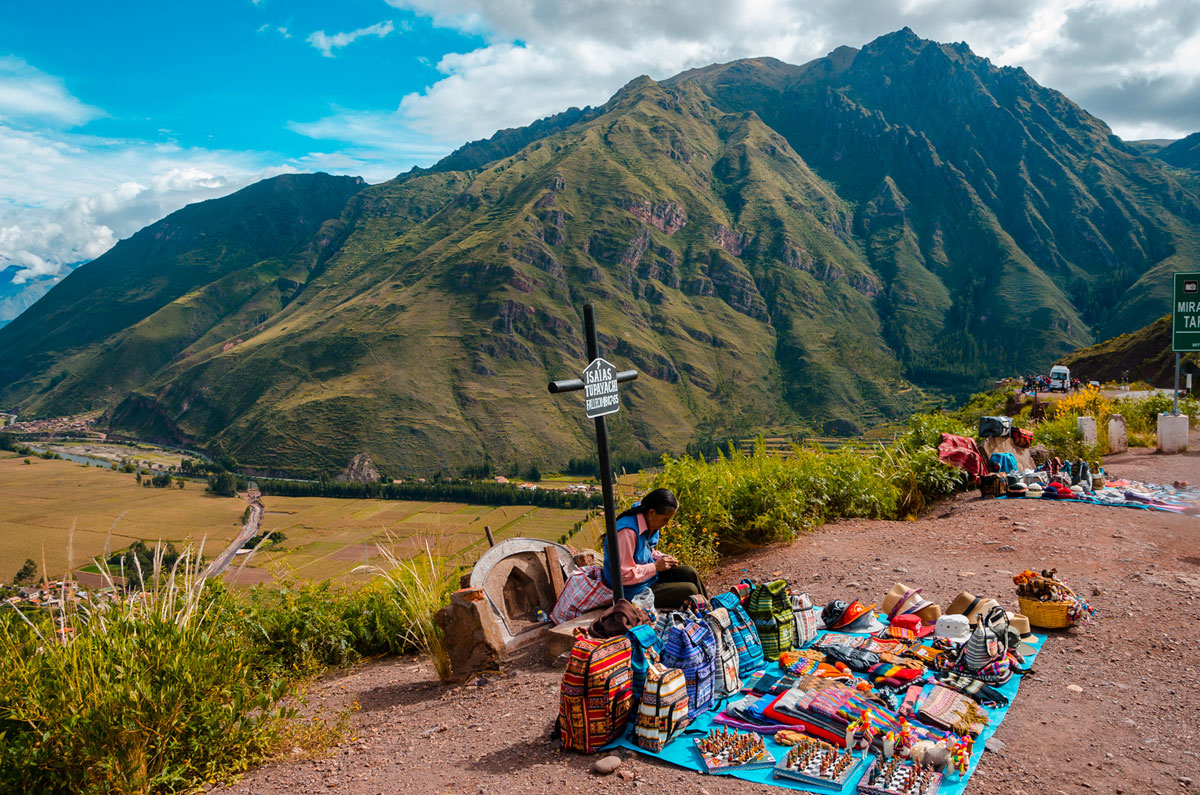Introduction
We traveled to the heart of Inca country to see the remnants of their civilization in the towering Andes, such as these ruins in Pisac.

Afterwards, we traveled to the village of Pisac for lunch and walked by the shops and street vendors. We saw a woman holding something on a stick.

We looked closely and saw she was selling a small animal for food. It was a Cuy (pronounced Coo-ee), the local name for guinea pig. Even though it was being offered on the roadside, it is considered a delicacy. We later saw it served in a restaurant.
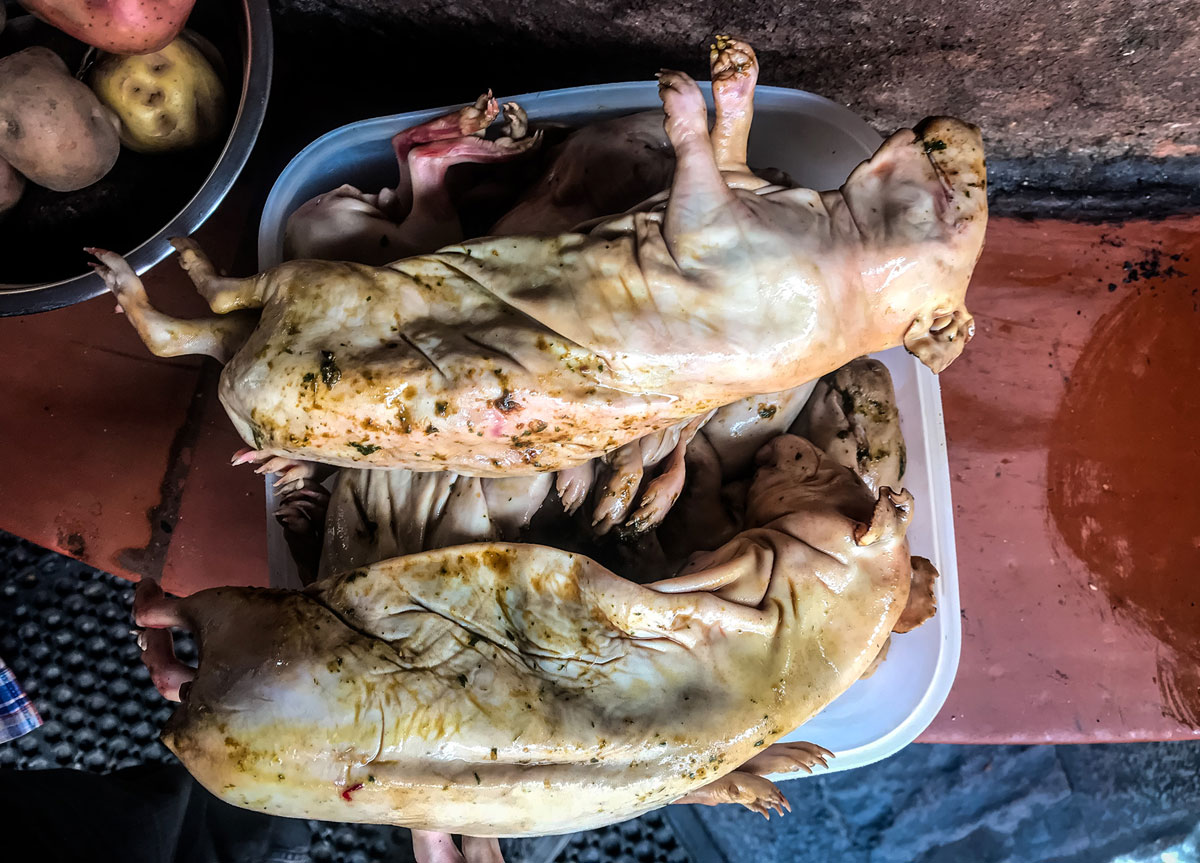
It was another reminder. We did not know much about the Incas, nor the local traditions. But that’s why we travel, to learn and experience.
Our Story
My wife Khadija, our friend Steve and I had been travelling through Bolivia and Peru in April 2018 experiencing the culture and acclimating to the high altitudes. This stop was in Cusco, which is the jumping-off point for Machu Picchu and the Inca Trail. For three days before our Inca Trail hike, we wandered around and visited the nearby Sacred Valley which has monumental Inca ruins. In Cusco, we were joined by our friend Nick whose work schedule constrained him to a much shorter acclimation time.
Cusco
Cusco has a history spanning 3,000 years. It is believed to be the oldest city with continuous inhabitants in the Western hemisphere. There is architecture in the city from all eras of its history. Much of the ruins and complexes left in Cusco are from when the Inca Empire founded the city in the 1100s. The layout was designed in the shape of a puma.
When the Spanish came in 1533, they quickly caused the death of many of the Inca people through superior weaponry and disease. As a result, they easily conquered the city. Francisco Pizarro made Cusco the colonial capital. Shortly afterwards, in 1534, he moved the capital to Lima, where they had easier access to the sea. Because the capital was no longer in Cusco, it was somewhat forgotten in its mountainous isolation situated at an elevation of 11,150 feet (2500 meters). As a result, many of the Inca buildings were left untouched as the Spanish focused on building up their more accessible cities. There was still colonial construction in Cusco, but not to the same scale as Lima and other and other cities.
In 1780, an uprising took place as natives and mestizos tried to overturn the Spaniards. While the revolt was unsuccessful, it is credited with leading the way to Peru’s eventual independence in 1821. Today Cusco is a UNESCO World Heritage Center. Every year, an estimated two million visitors come through the city. By the time we left, I felt it was a place that merited spending at least three days in.
Plaza de Armas
Our accommodations were near the Plaza de Armas, the commercial and social center of the city. The buildings across from the plaza, many of them churches, are set back, giving it a refreshing, open atmosphere. We passed through it several times and sometimes lingered to watch local life.
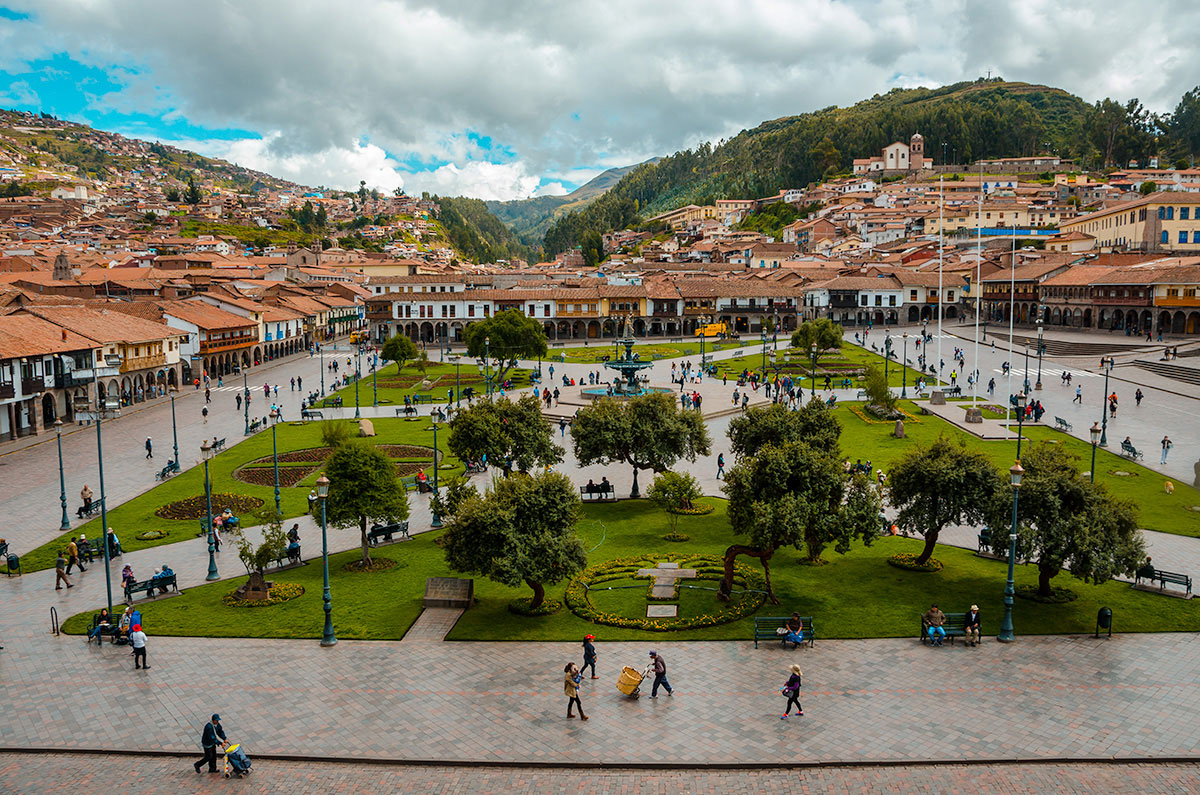
Cusco Cathedral, or the Cathedral Basilica of the Assumption of the Virgin, is one of the oldest colonial buildings in Cusco, as construction began in 1560. It took almost 100 years to finish and became an important symbol of Cusco’s colonial era. In the early 1900s, the cathedral became a minor basilica and the official seat of the diocese. It also became a UNESCO World Heritage Site in 1983.
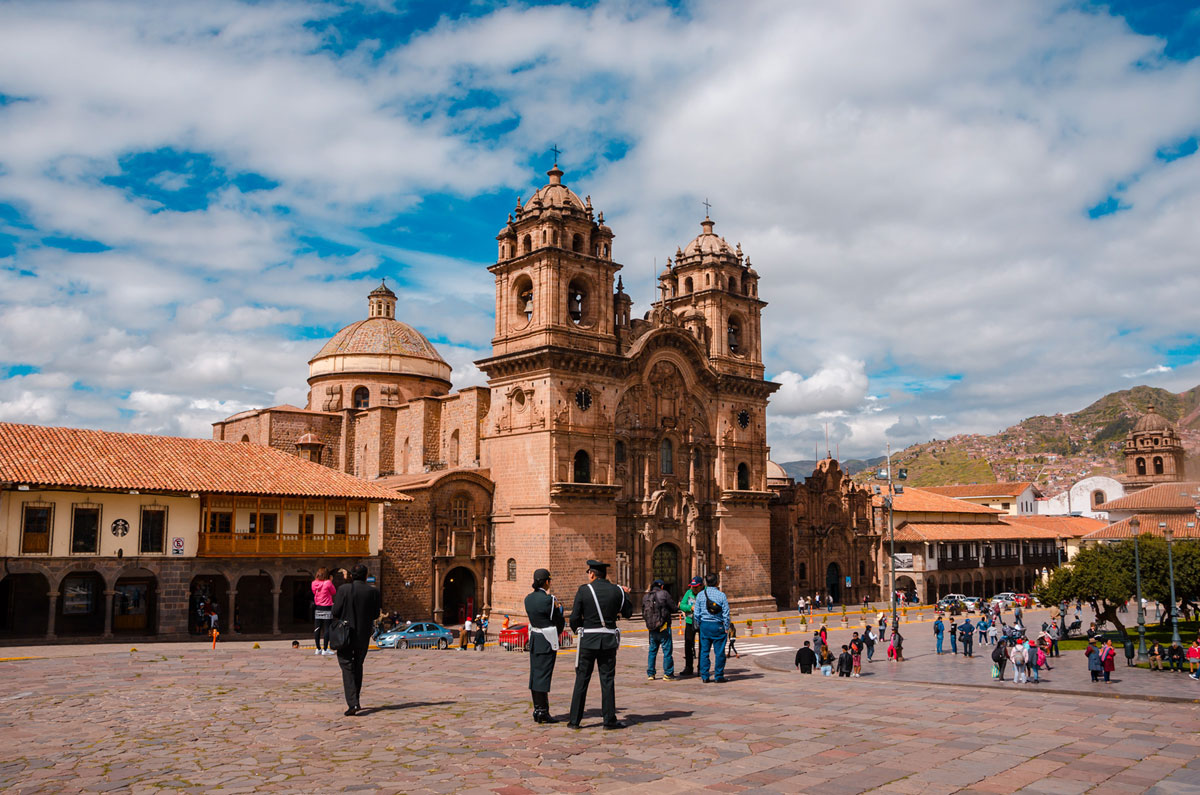
Many of the stones that were used to build the cathedral were from Saqsayhuaman, a nearby fortress. It was initially contructed by the Killke people, starting in the 900s. The Incas took it over in the 1100s and expanded it in the next two-centuries.
I particularly liked the bell towers which are a combination of Gothic, Baroque and Renaissance styles.
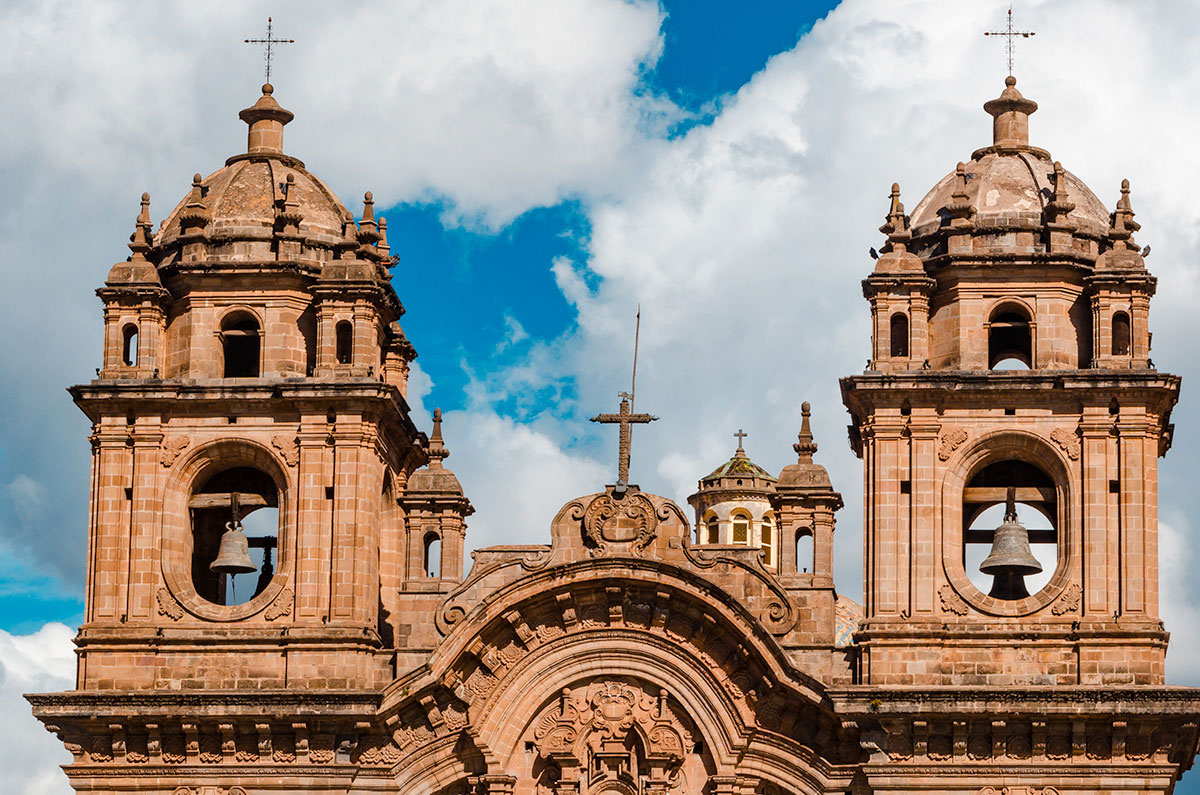
We climbed to the top for a view of the plaza and observed the daily activities…

…and the rooftops of the city.
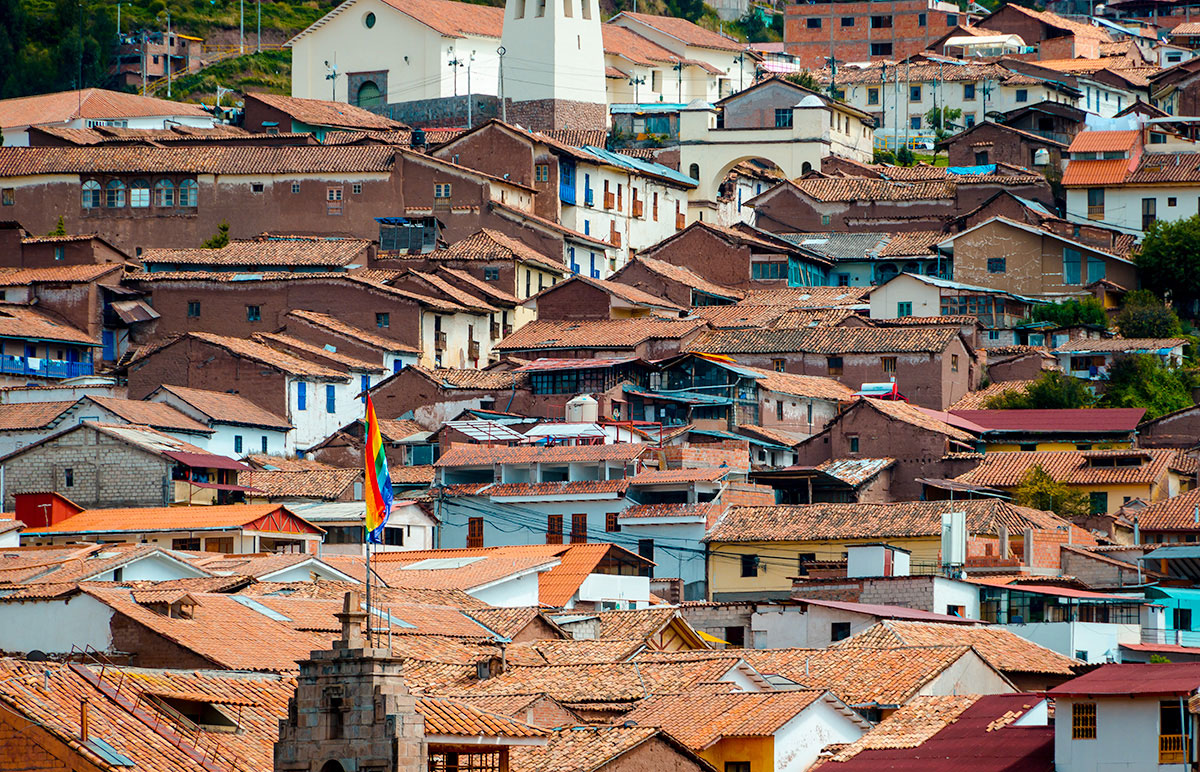
Around on the right side of the cathedral is the more modest but impressive Triunfo (Triumph) Church, which was also built on the site of an Inca building (as is almost every major building in Cusco).
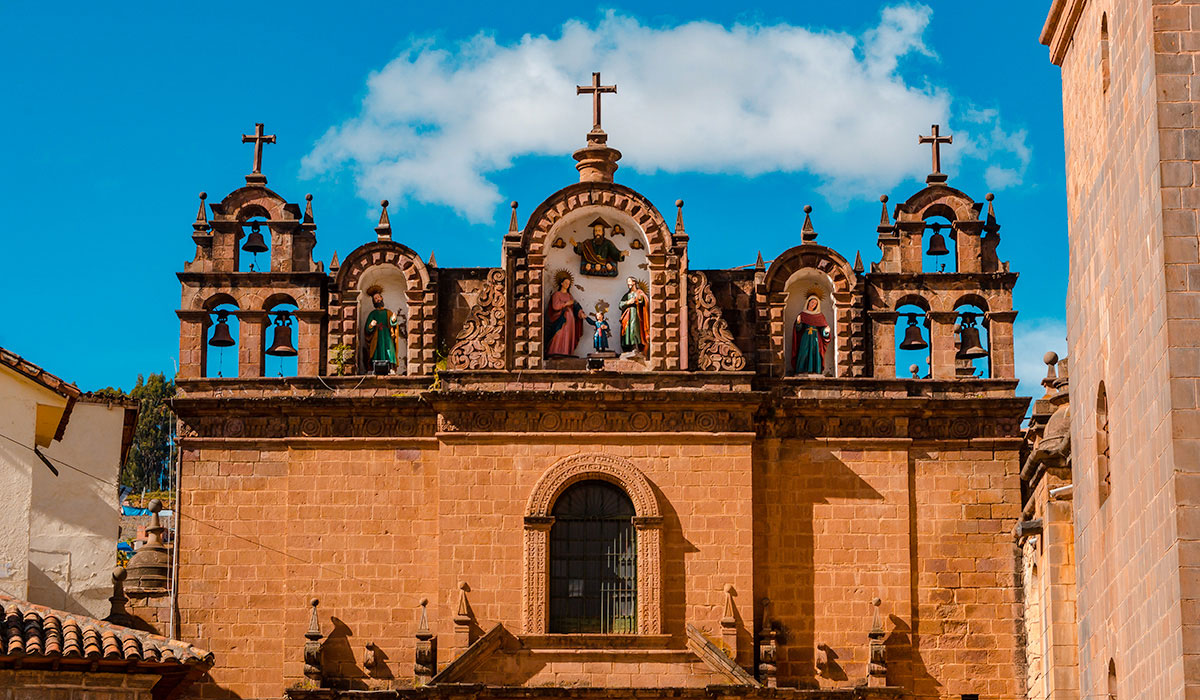
The Church of the Society of Jesus was built in 1571 by the Jesuits. The plan was to make the church into the grandest in Cusco, but the archbishop refused to allow it to rival the cathedral. The pope eventually mediated and ruled in favor of the cathedral, but by the time the ruling came in the Jesuit Church was very nearly done. The building is the best example of Baroque architecture in Cusco but had to be heavily restored and reconstructed after an earthquake in 1650.
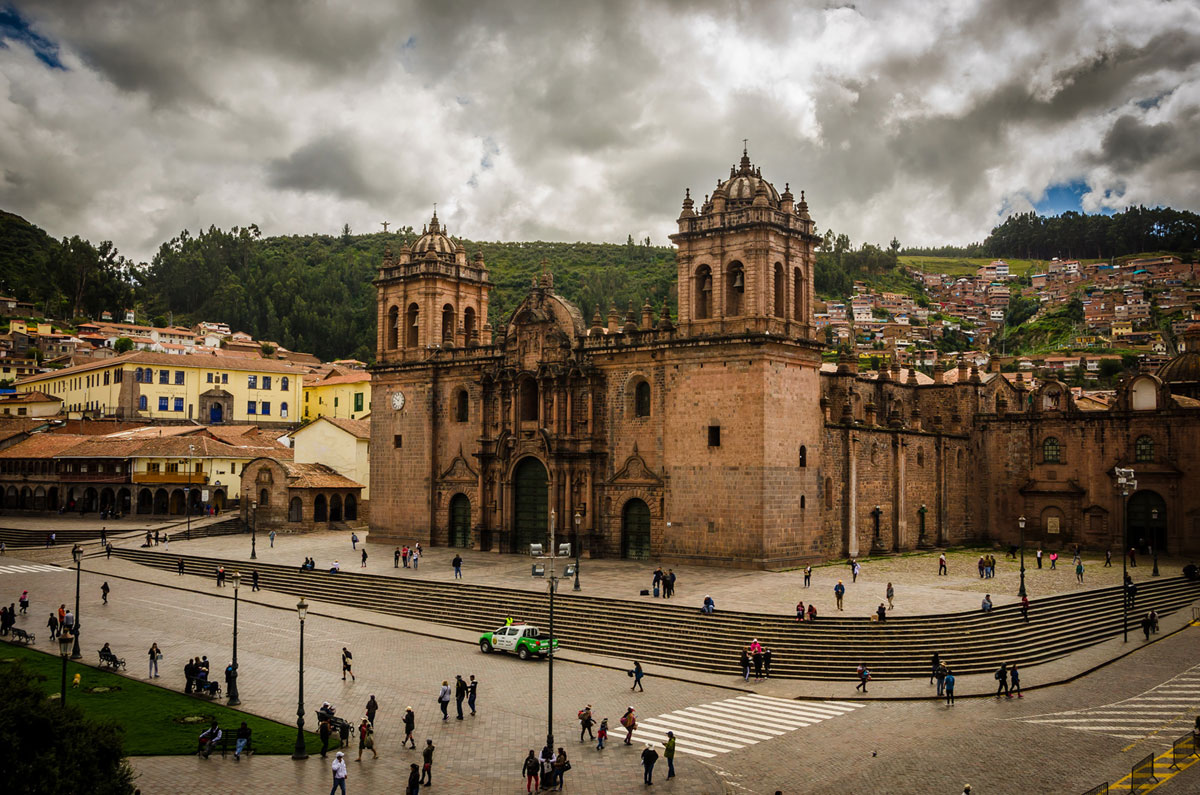
There was a celebration on the side of the church where worshippers came to every night we were there.
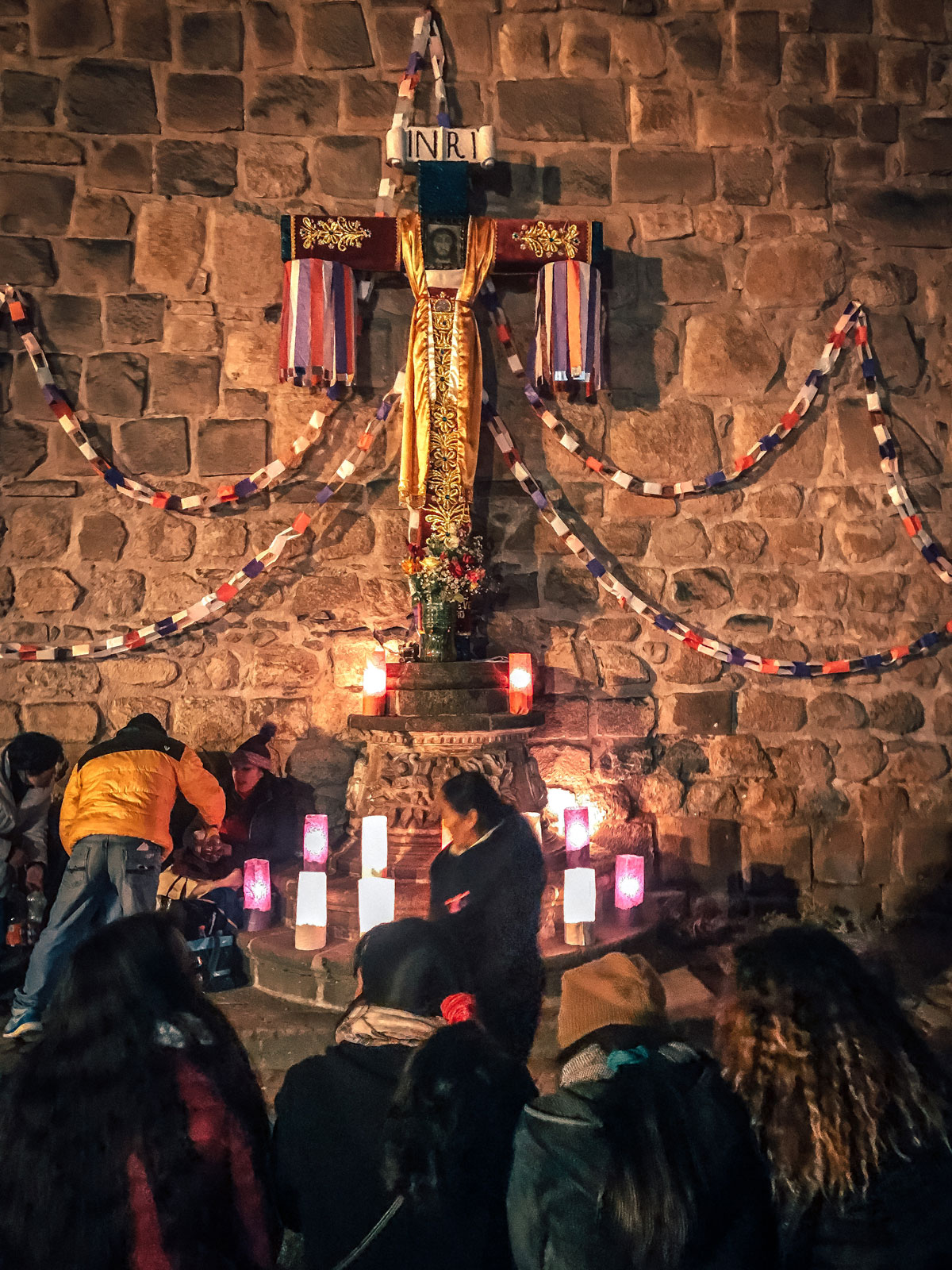
Following our usual modus operandi, we hung out at the plaza to watch the marching bands…
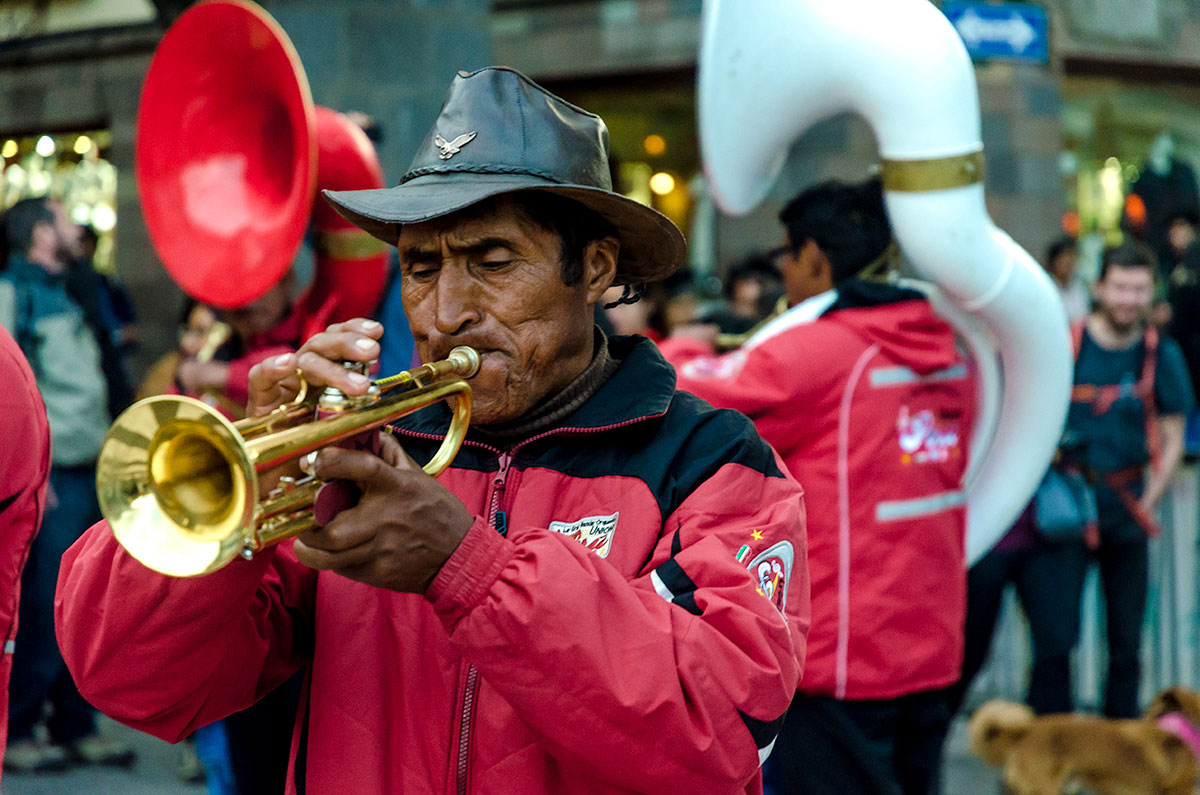
… and the folks enjoying the plaza’s peacefulness, occasionally interrupted by parades and protests.
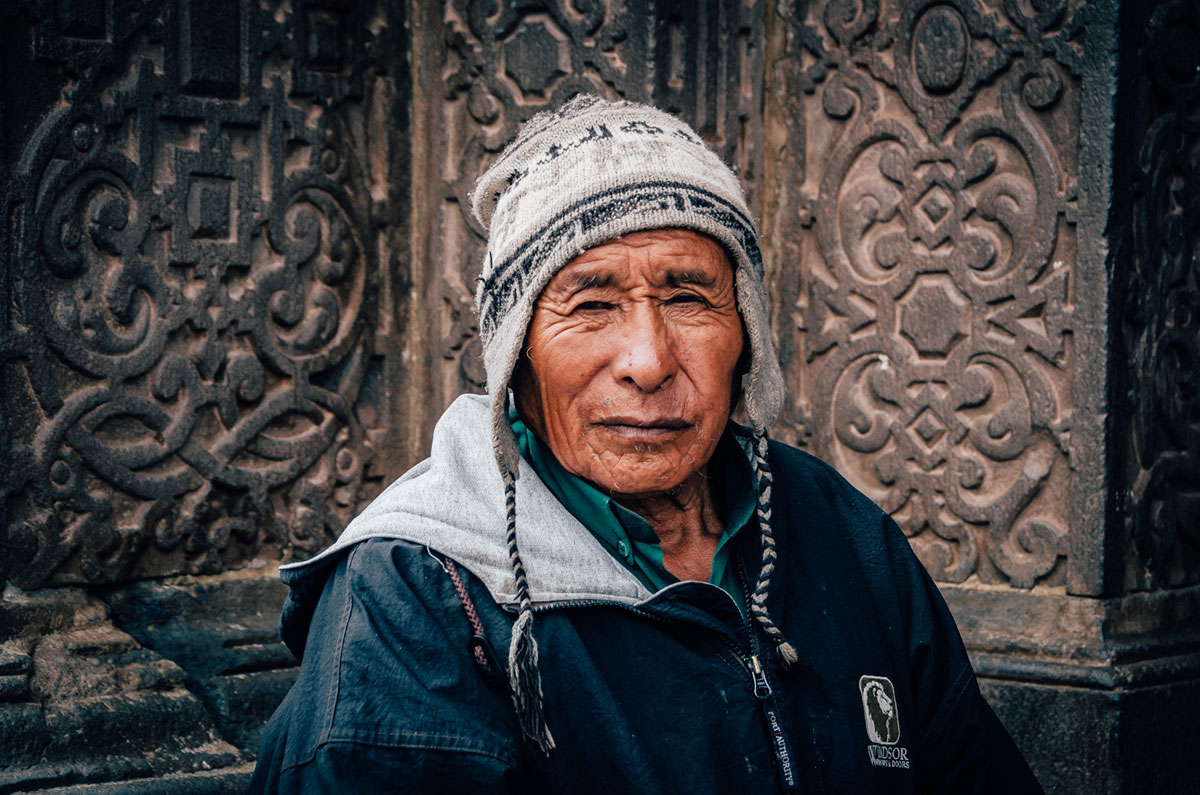
Museums
The Museum of Pre-Columbian Art sits inside a colonial mansion and holds a large collection of artifacts from Peru’s many ancient civilizations. The dates of the artifacts and historical accounts range from 1250 BCE all the way to the start of the colonial era in the early 1500s. Quite a bit of the work is jewelry-sized or relatively small. Here was a wooden human figure, about foot and half tall and one of the oldest on display.
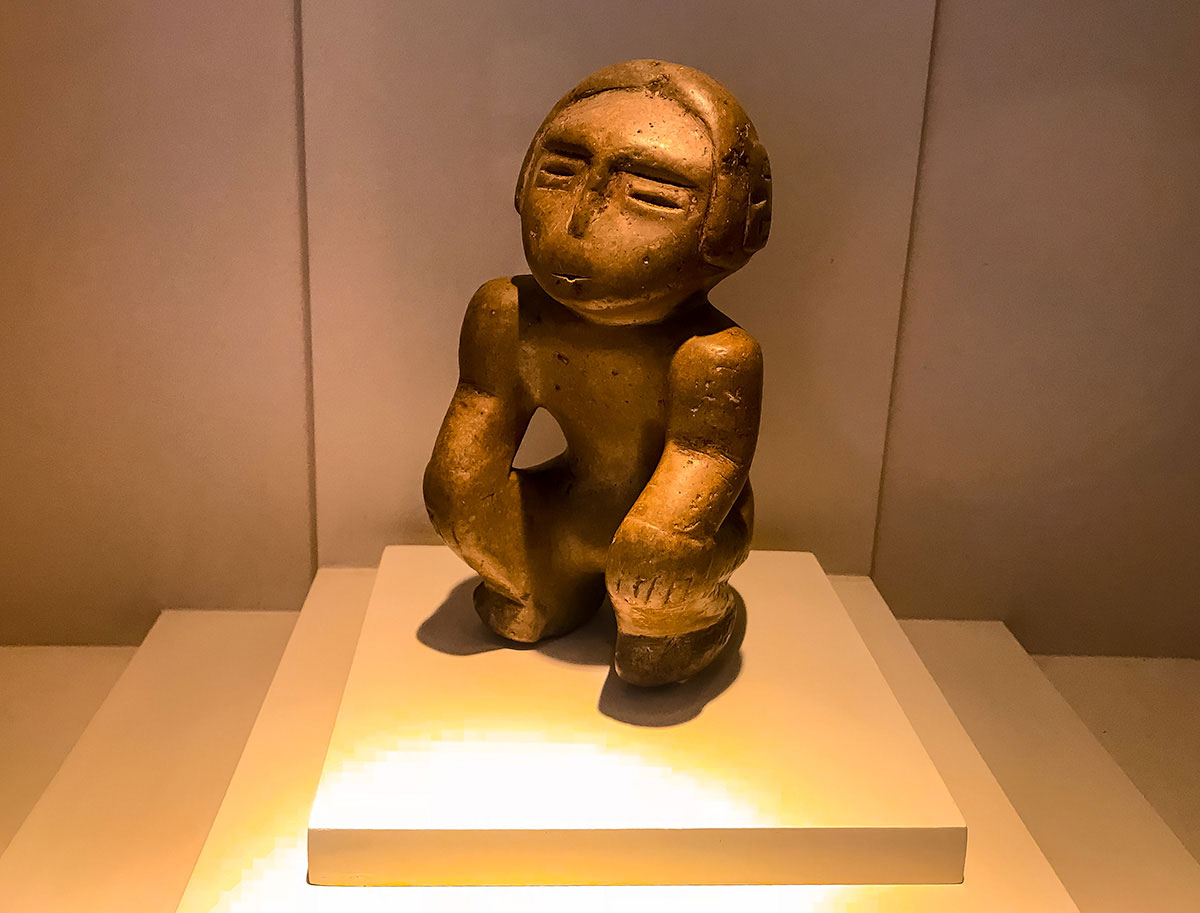
The pieces that are on exhibit are all from the Larco Museum’s world-renowned collection in Lima. There are over 400 pieces displayed in ten rooms providing very good information on the collection.
The Inca Museum is a block away from Plaza de Armas and is an excellent repository of Inca history. The museum is within the Admiral’s House, one of the most impressive colonial houses still standing.
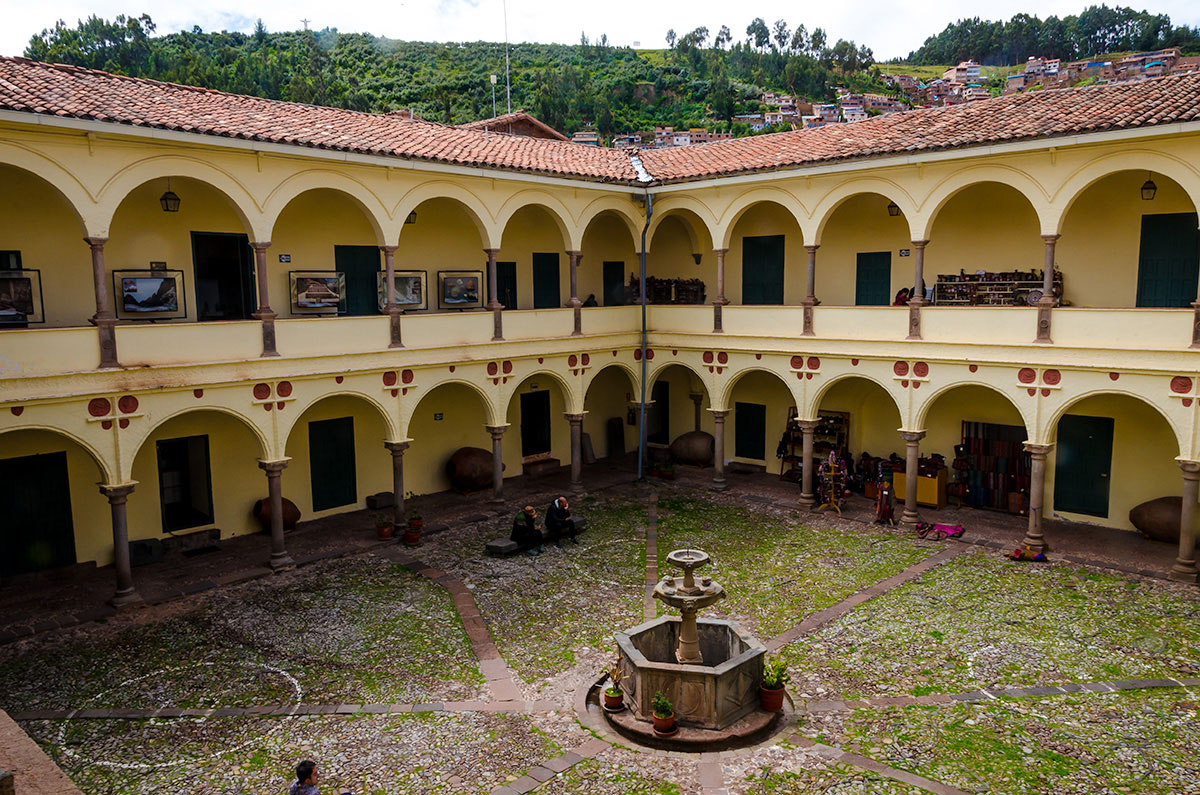
Inside the museum is a large number of historical items and dioramas. It had so much information, we were overwhelmed and viewed only a few areas in detail. However, I noticed this window with colorful tassels.

The most impressive museum and important building in Cusco is the colonial monastery of Santo Domingo. It was built on the foundation of the Inca temple Coricancha (many variations in the spelling). Many walls are partially Inca granite blocks assembled without mortar (more on that later in this post). The highest wall is 20 feet (6 meters).
Coricancha means courtyard of gold. The name was not puffery. When the Spanish arrived, they found the walls and floors covered with sheets of pure gold. The Incas had filled the courtyard with life-size sculptures of animals and corn, made of gold and silver. The courtyard today is an empty space except for flowers pots.
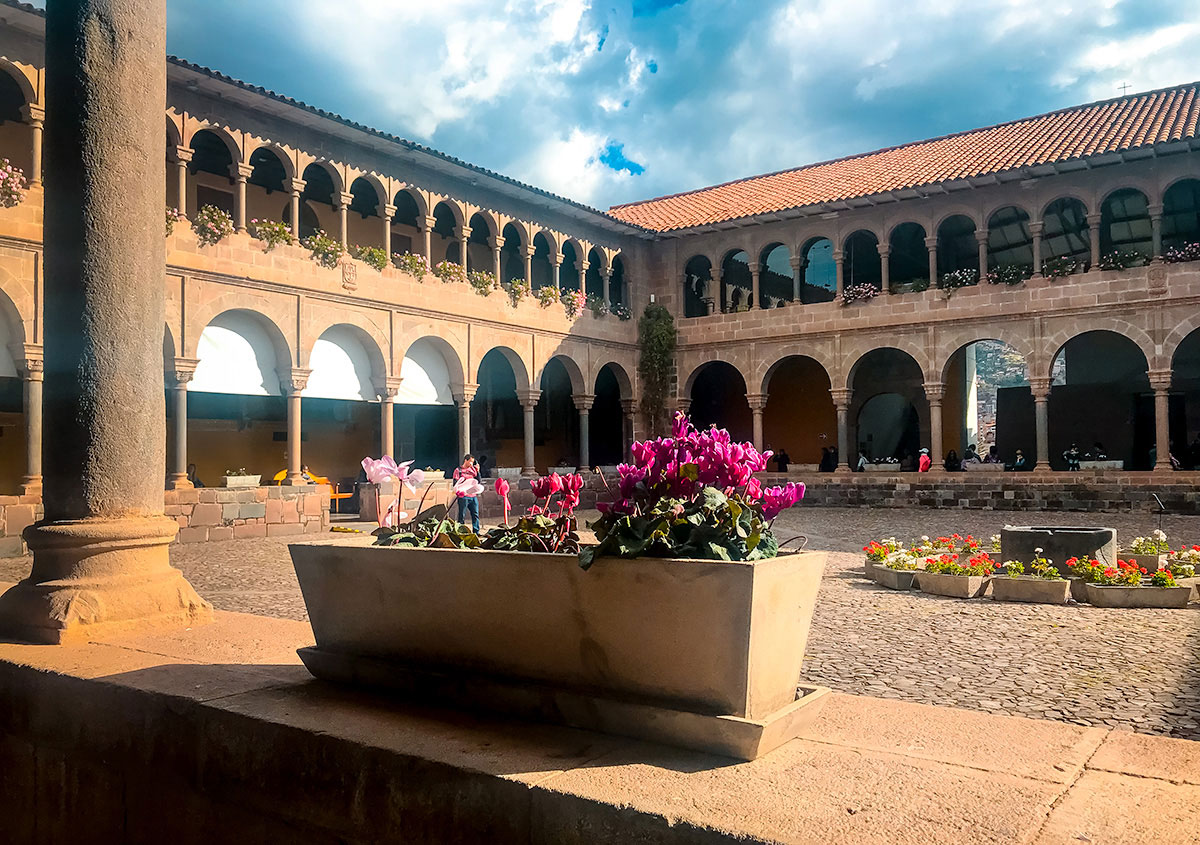
Not surprisingly, this was the most important temple in the Inca empire.
Of course, the Spanish stripped, melted and absconded with the precious metals. Preserving indigenous culture was not a priority. In fact, they wanted to destroy the pagan beliefs and accomplishments. They sacked and destroyed many Inca buildings and art. All the while, they were vastly enriching themselves.
One highlight of Coricancha is a metal sheet showing the arrangement of symbols that were once displayed on an altar wall in the temple. It was made by a son of a Spanish noble man and an Inca Princess. There is still debate on what it shows.

One thing is certain, it is an amalgamation of Inca and Christian iconography. For example, there is man and a woman. To Christians of that era, they were Adam and Eve, frequently referenced in early colonial art. To the Inca viewer, they would have seen the woman pouring liquid on the ground as an offering to Pachamama, the goddess of the Earth. For Christianity to convert the indigenous, it had to incorporate some of their traditional religious beliefs, a practice still ongoing.
We wisely hired a guide standing by the entrance who knew the history and the astronomical significance of the architectural features. He took a picture of us (left to right, me, Khadija, Steve, Nick) by Inca walls.

Before we left, we went to the second level, where there was an art exhibition, book and gift shop and very good views of the courtyard and the bell tower.
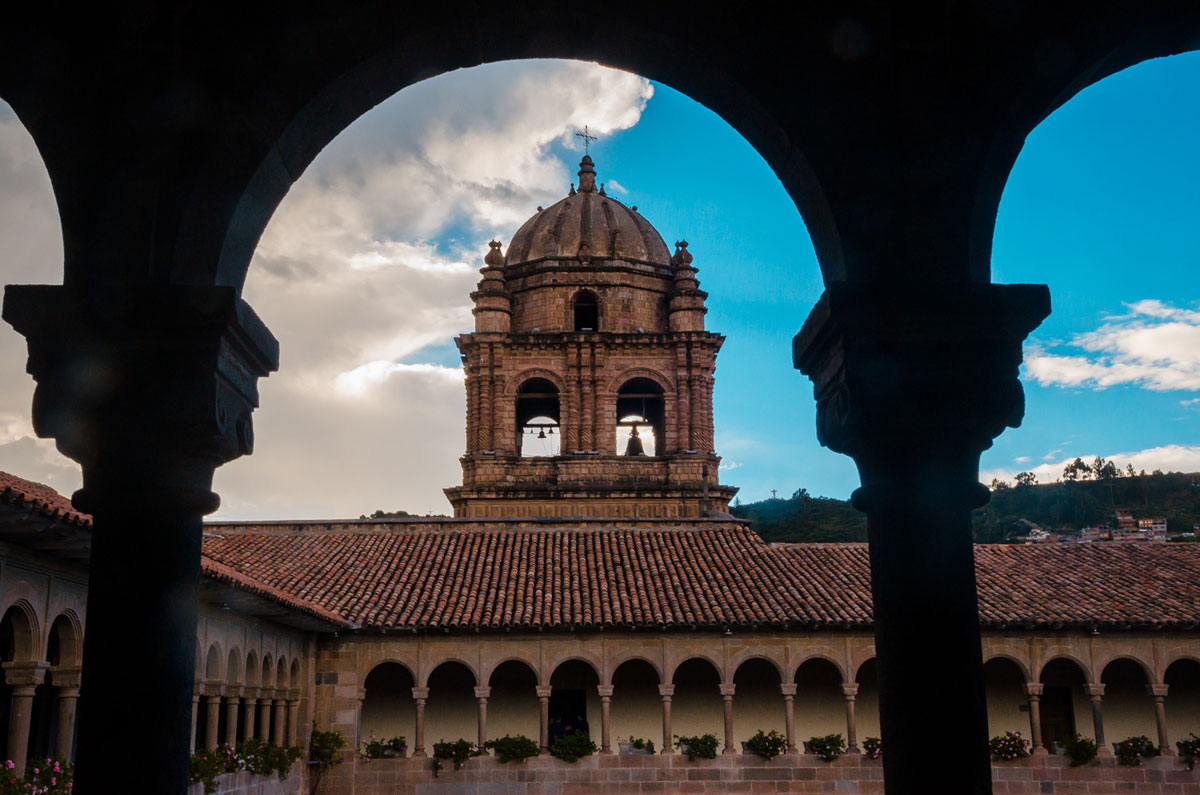
City Streets
The city is fun just to walk the streets, most narrow and steep.
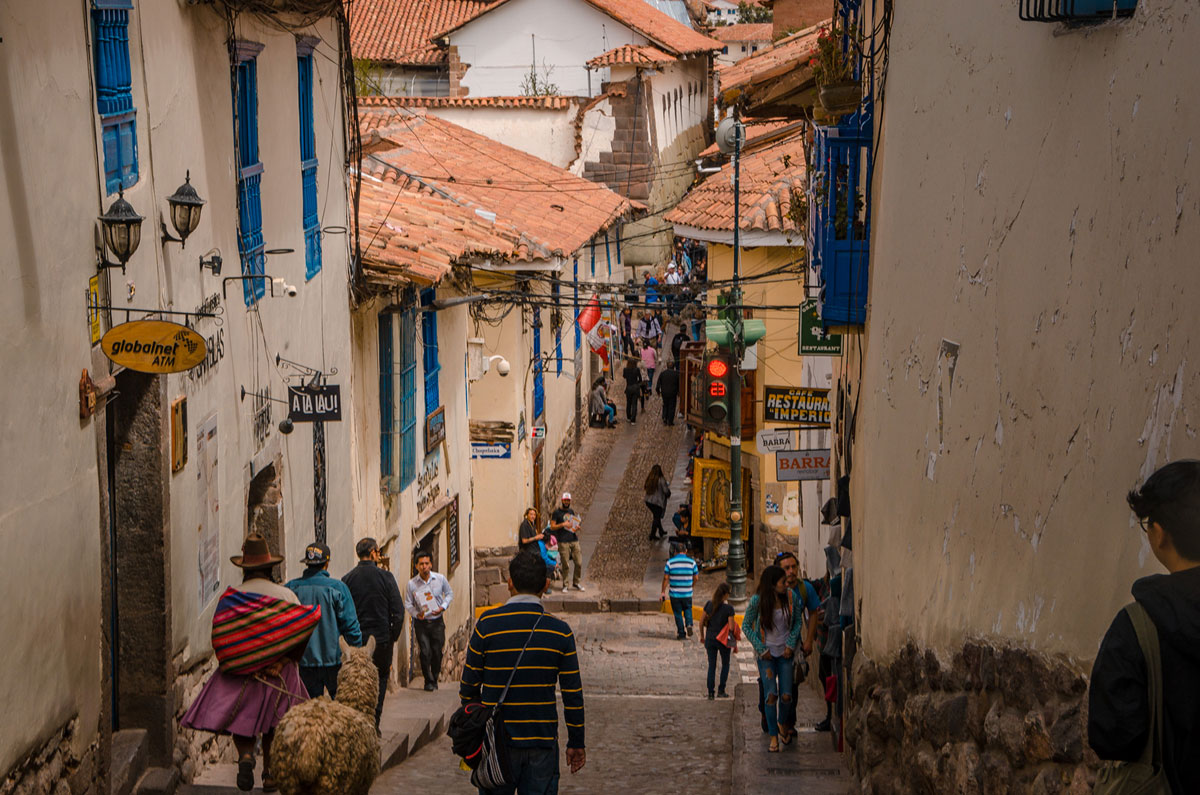
It is not only churches built on Inca foundations, but many buildings throughout the city, as illustrated with the stone under the balcony in this picture.

Throughout the city are colorful small markets selling textiles and souvenirs.
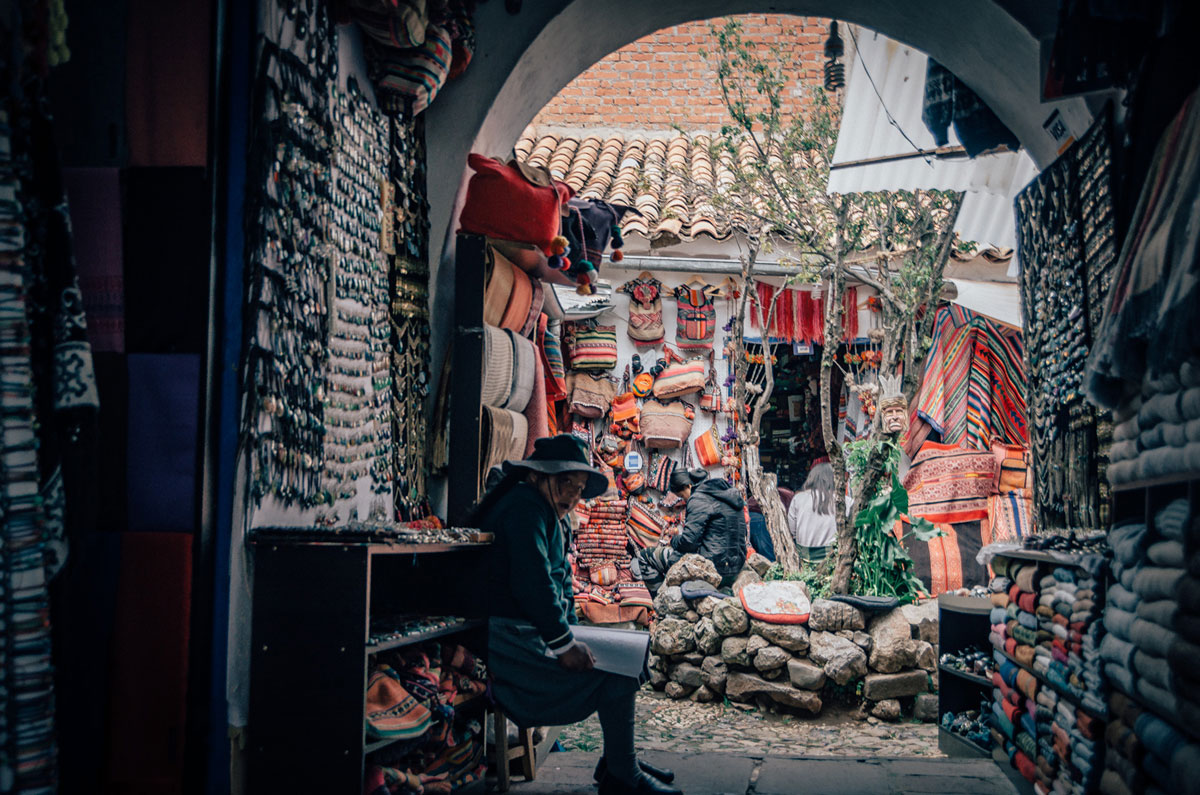
There are scads of restaurants at various price levels, as well as bars often with live music. We went to Quilla Restobar, close to the Plaza de Armas, located on the second floor. It was an unpretentious pub with only a few other patrons and a live guitarist. Nick, an accomplished musician and song writer, borrowed the guitar and performed an original piece.
So, what’s not to like about Cusco? It is historic, atmospheric and fun.
Sacred Valley
The Sacred Valley includes part of the Andean Mountains and the Urubamba River Valley. The Incas that settled this area valued it for the rich soil and diverse wildlife. The altitude in the valley is lower than that of Cusco. We took a bus tour that lasted most of the day to see Pisac and Ollantaytambo, two of the main archeological sites and villages.
Pisac
The ruins in Pisac feature gently-curved agricultural terraces, which allowed farming on steep slopes and irrigation that remains on the crops and not flow downhill.
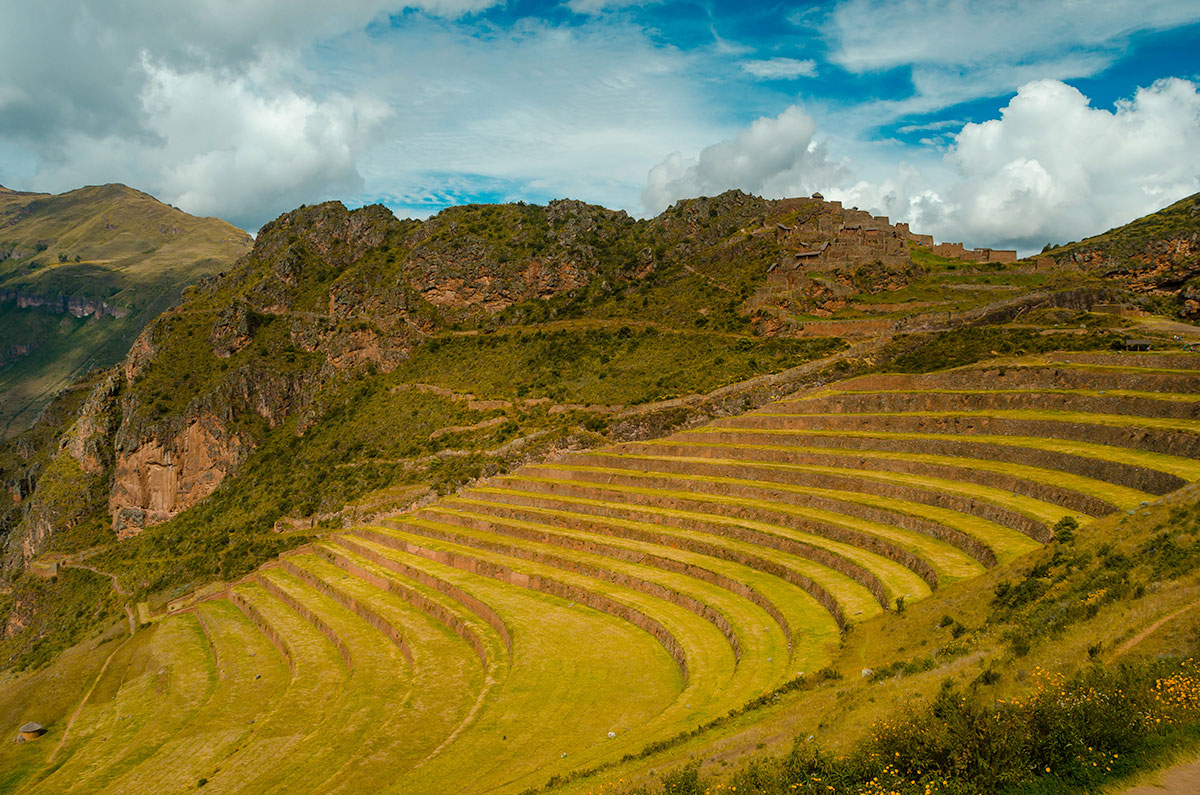
From our vantage point, we saw the panorama of the valley.
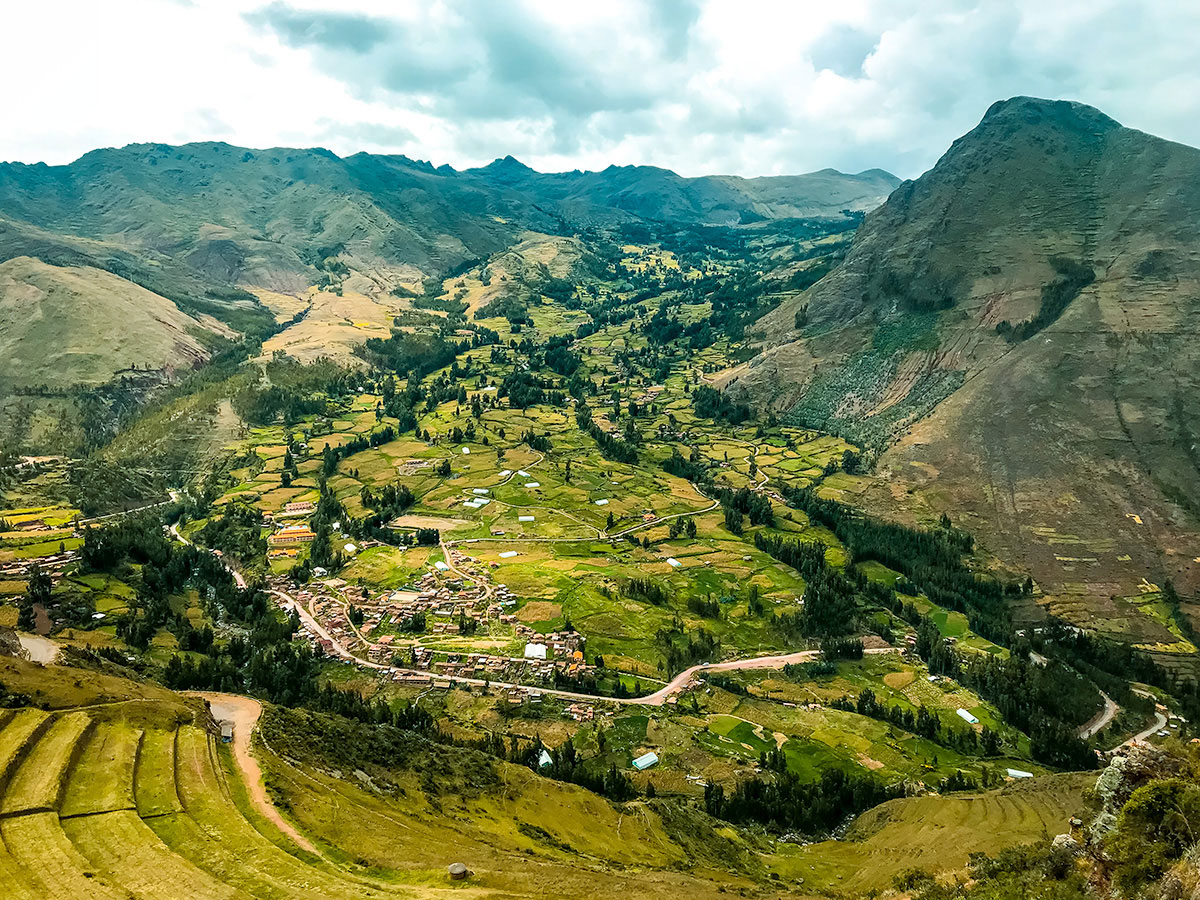
There is also an ancient cemetery where an approximated 3,000 Incas are buried.
The village of Pisac has a large market that specializes in souvenirs, jewelry, alpaca fur goods and pottery.
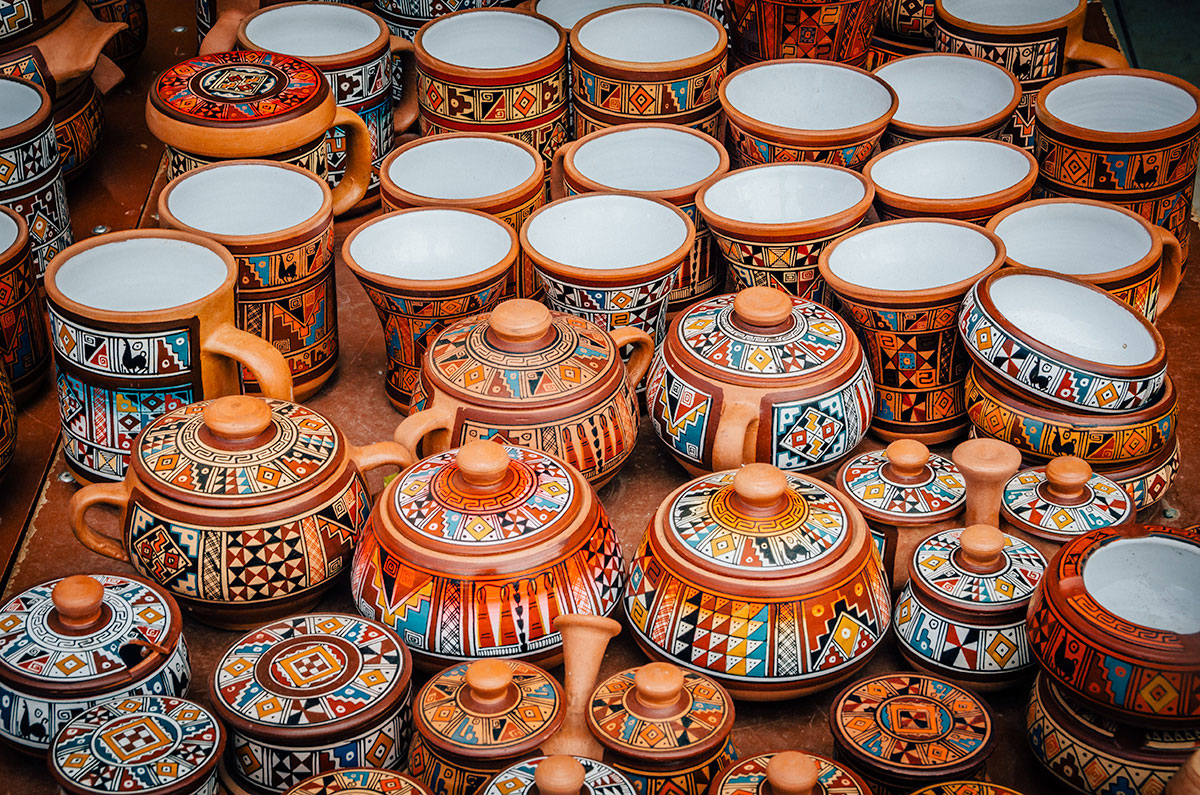
The vendors and non-tourists on the street are mainly indigenous folk, some with llamas…
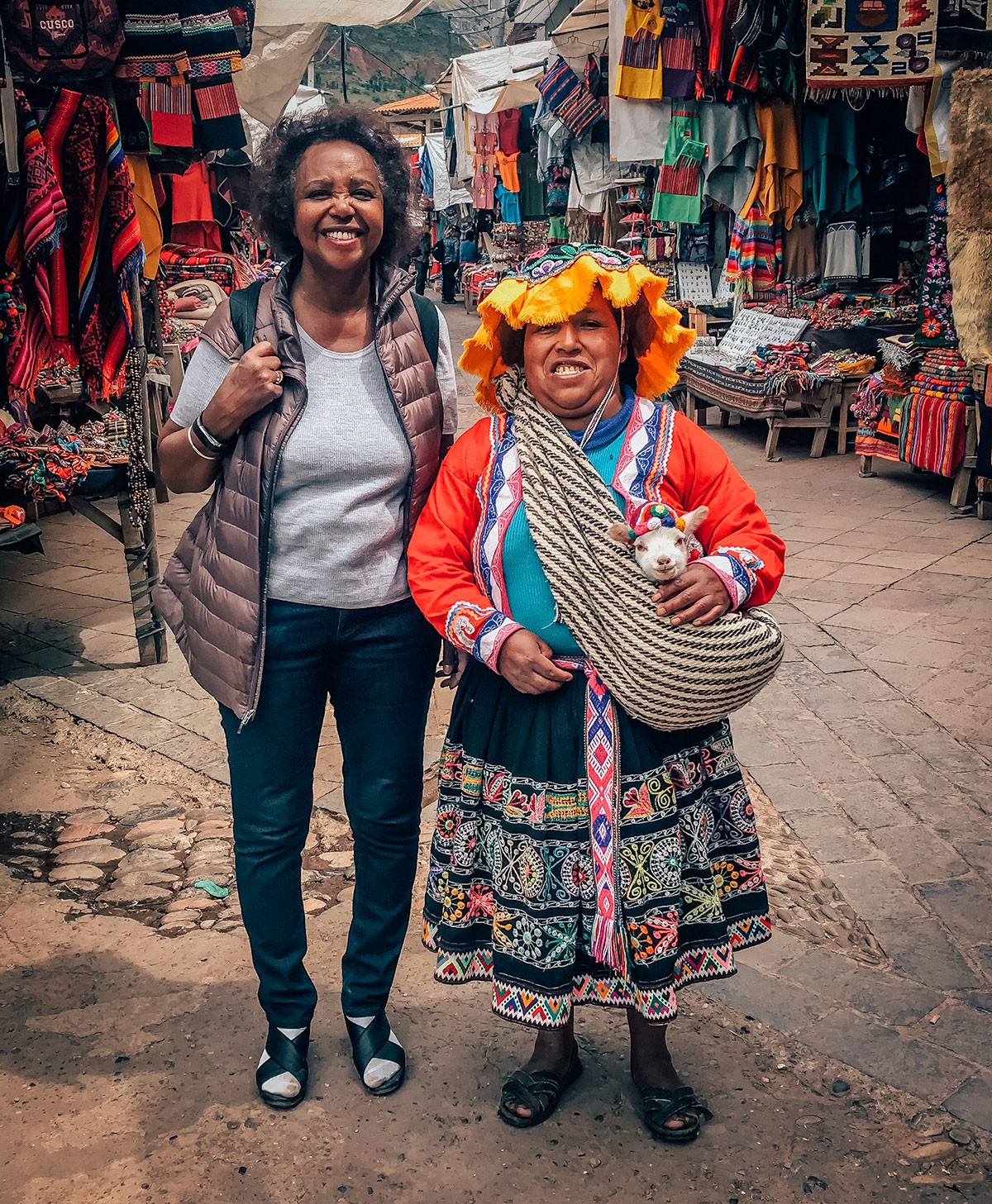
…and some with huge loads on their backs.
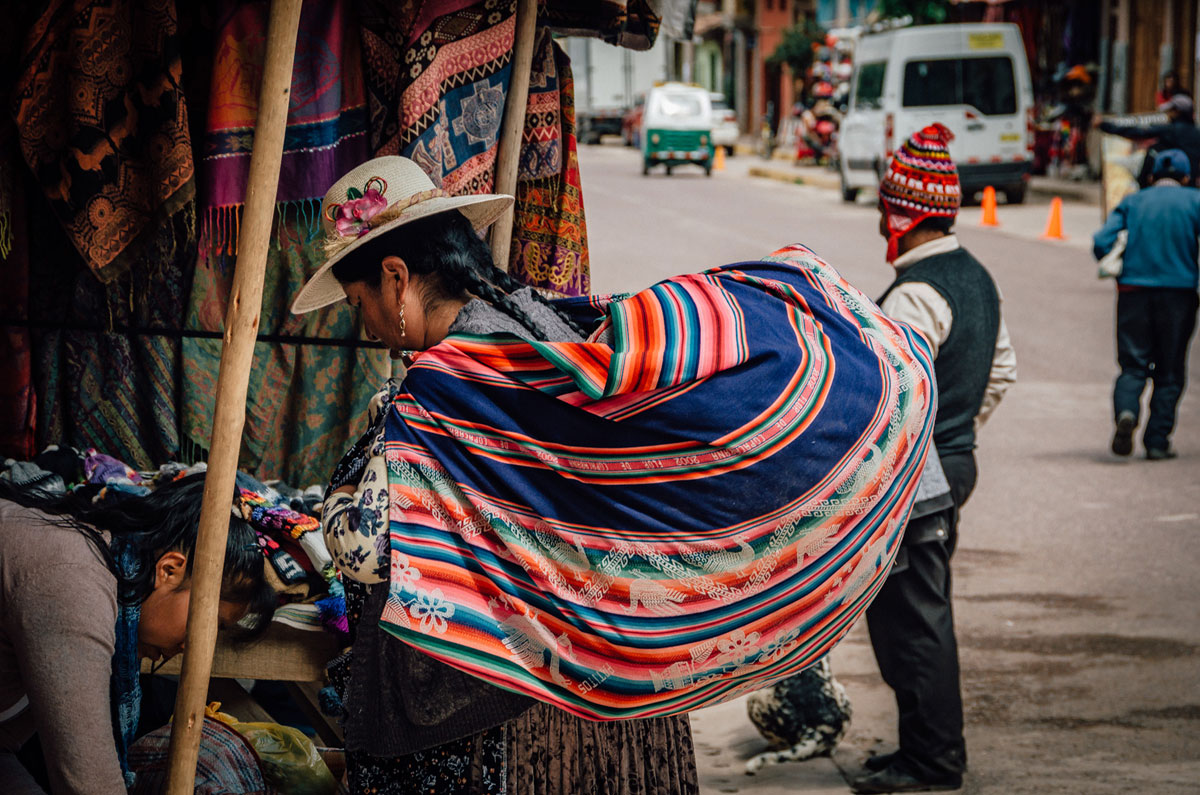
In Bolivia, Peru and Colombia, we saw many Volkswagon Beetles. Some were several decades old, but many were recent ones made in Brazil and Mexico. We got a kick out of this modified one with missing features.
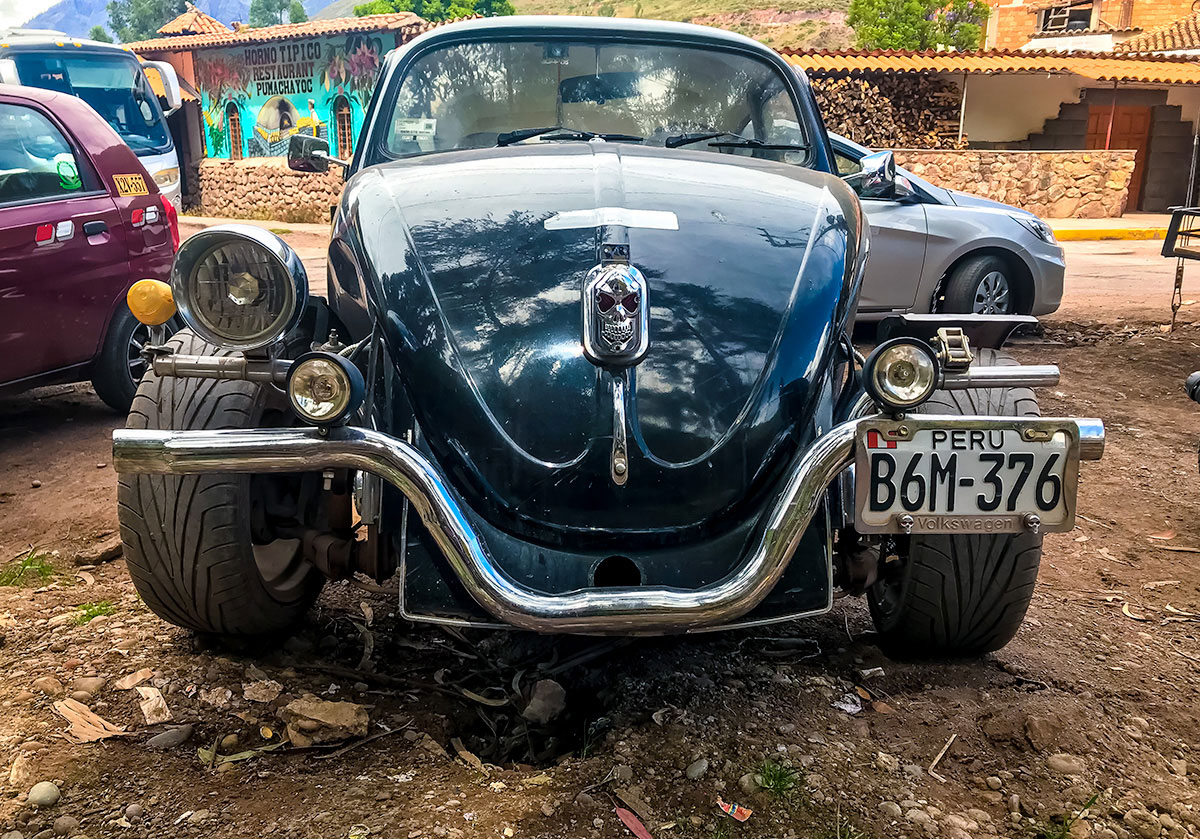
Notice the restaurant mural in the back, this is a landmark for the village.
Ollantaytambo
Ollantaytambo is known for its stone terraces and well-preserved ruins.
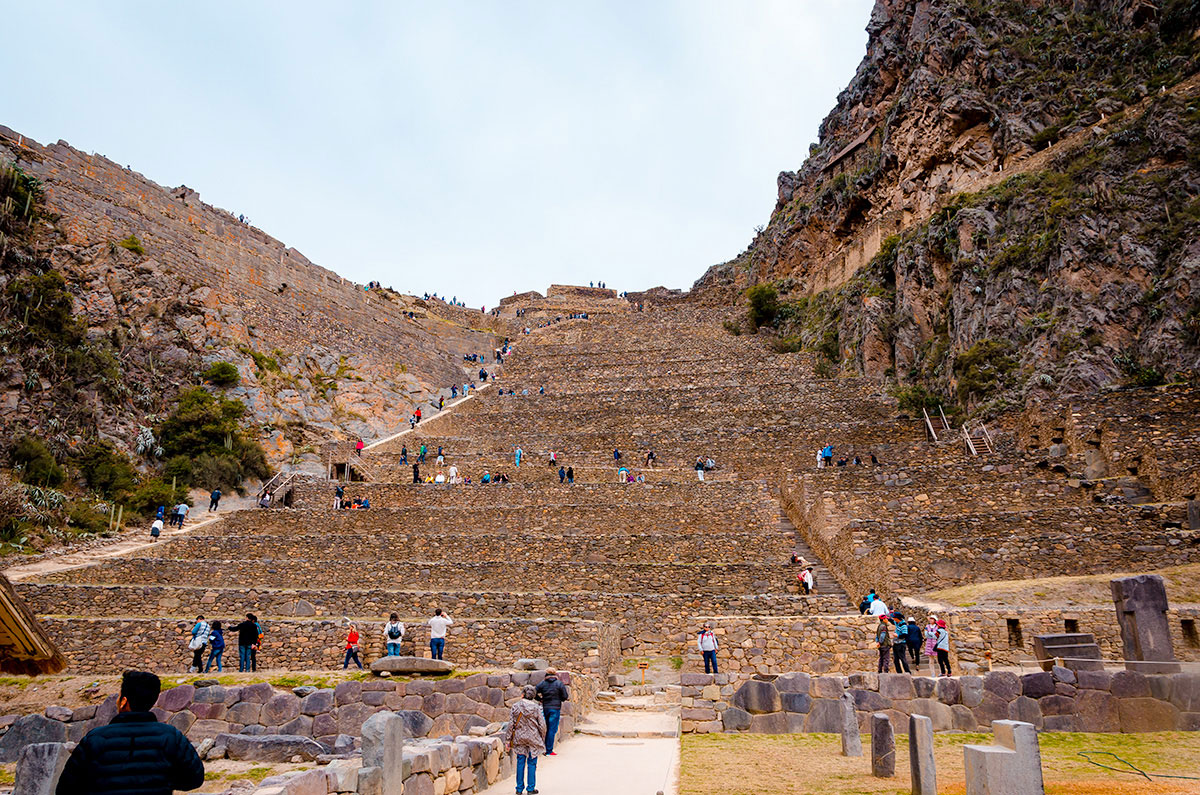
Each terrace level is quite high, up to 50 feet (15 meters). On each site throughout the Andes, their height was partially determined by the changing climatic zones as the hill went higher. Probably because this area was the home to Inca nobility, the walls were made of cut stones instead of rough fieldstones. This is the only site where the Inca won a battle against the Spanish using the terraces are barriers and flooding the valley. On the top of the steps are the remnants of a fort.
This an excellent location to see the sophistication of the Inca stone masonry. As they were still building when the Spanish invaded, there are uncut and partially cut stones never placed.

The Incas mastered making stone walls that lasted centuries, all without mortar. They did this using protrusions wedged into holes of the accompany blocks, as you can see in this unfinished wall.
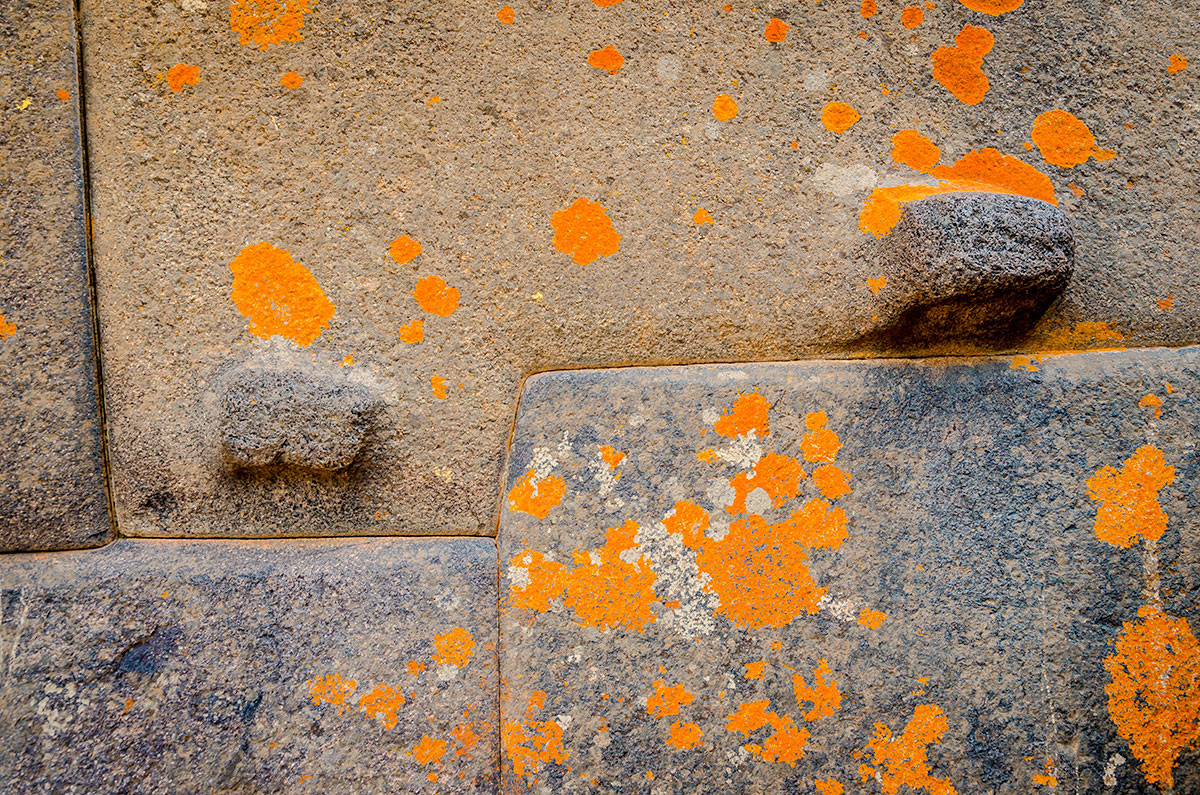
They finely cut each stone, using stone hammers, that fit together with incredible snugness and in a pattern to absorb shock during periodic earthquakes. For style they made trapezoidal windows (no arches) and tilted walls.
The most astonishing aspect of their work is how they carried incredibly heavy stones from the quarry to the building location, often up steep inclines, without knowing about the wheel. They did it by using tens of thousands of workers dragging them over gravel-covered roads and ramps, which incidentally polished them.
After we huffed and puffed up the hill, we turned around and saw the magnificent valley and the village of Ollantaytambo.
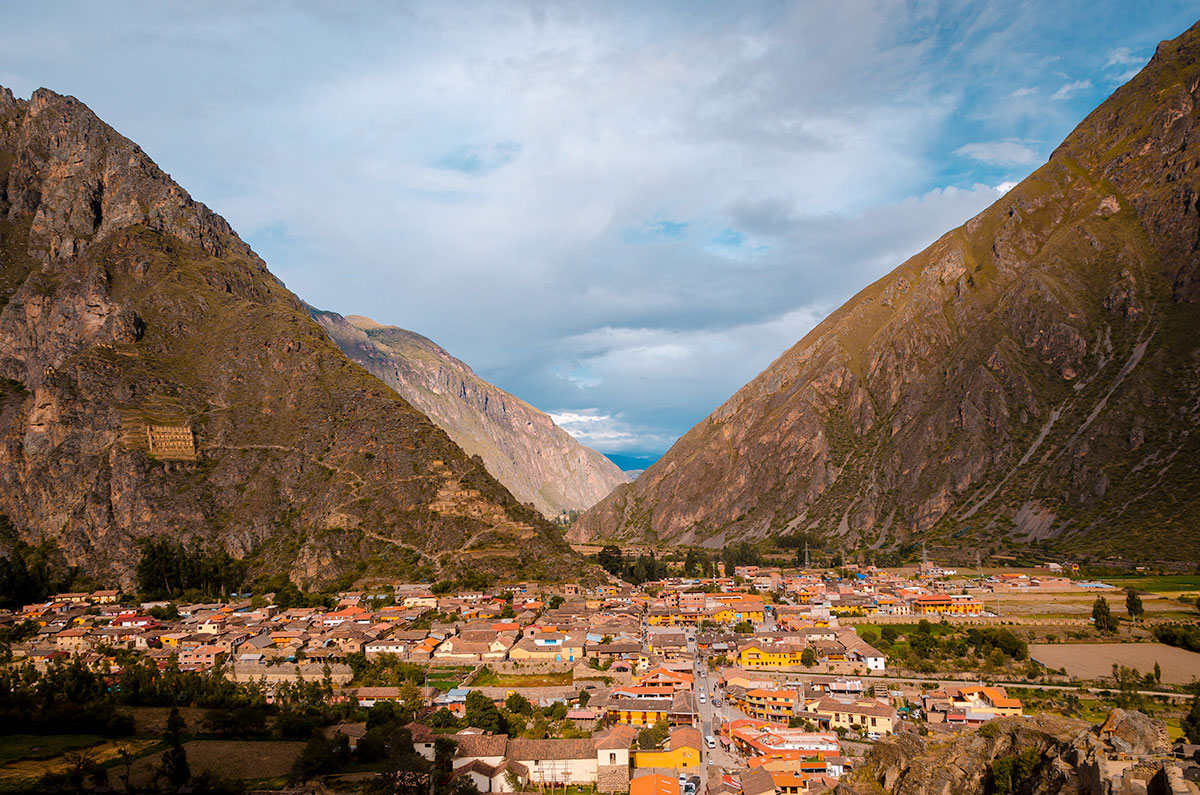
The mountain on the left, next to the Patacancha River, is the Tamboqhasa. It has stone terraces ascending to a temple and fortress ruins on a natural ledge.
Final Thoughts
After two weeks of acclimating to the altitude, experiencing local traditions and learning about Inca history, we were ready for the Inca Trail. See the next post: Peru – Part 2 – Inca Trail and Machu Pichu.

